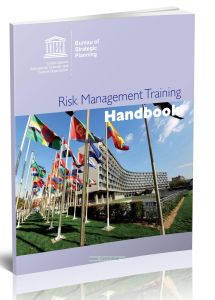- Артикул:00-01096151
- Автор: UNESCO
- Обложка: Мягкая обложка
- Страниц: 66
- Формат: А4 (210х297 мм)
- Год: 2010
- Вес: 153 г
Risk Management Training Handbook/Учебное пособие по управлению рисками
Книга на английском языке
The purpose of risk management training is to raise basic awareness of risk management concepts and mechanisms, to enable participants to identify and manage risks in their own units and to strengthen project management through adequate forward planning of potential risks.
The half-day training module on risk management introduces the definition of risk and the purpose of risk management and discusses steps towards the effective management of risks. The course goes beyond the provision of generic tools and extends to re-visiting elements of organizational culture, decision making and situational awareness. Practice case studies and exercises are proposed at the end of the training session, and participants are requested to undertake a mock risk analysis using the methodology described in the module.
By the end of the training session, participants should be able to:
Understand UNESCO's approach to risk management;
Understand how risk management affects decision-making;
Conduct a risk analysis by drawing up a risk profile and using a risk matrix;
Identify risks/uncertainties to achieving a set of objectives and expected results;
Prioritize these uncertainties; and
Decide how to act on the uncertainties within the framework of project planning.
This handbook summarizing risk management methodology and the various concepts discussed during the training session accompanies the training module and is designed as a guidebook for future reference. It therefore follows the structure of the training module and covers a fairly extensive review of risk management concepts using examples to help develop a general understanding of the subject. It will help participants set up a risk profile and a risk management plan for their own units or divisions.
As a follow-up to the training session, BSP will offer advice on integrating risk management into workplans and their everyday activities. Risk management is intended to become an integral element of project management and a component of results-based management (RBM).
Contents
Part I: Risk Management Definitions
And Basis Concepts
(I) The Purpose Of Risk Management
Why Manage Risks?
Applying Risk Management Concepts To UNESCO
(II) What Is A Risk?
Definition Risk Categories
Causes, Effects, Uncertainty And Objectives What Risks For UNESCO?
(III) What Is Risk Management?
Definition
Establishing A Risk Management Culture Within UNESCO
Part II: I Mplementing Risk Management
(I) Step I - Clarify Your Goals And Critical
Stakeholders
(II) Step II - Identify Prioritize, Act
Identify Risks Prioritize Risks Act On Risks
(III) Step III - Monitor, Review And
Communicate Risks
Monitoring And Reviewing Risks Communicating And Reporting
Risk Management And Results-Based Management (RBM)
(IV) Quizz - Test Your Knowledge
Part III: Applying Risk Management To Your Division
(I) Risk Management In UNESCO: Who Does What?
(II) Major Risks Facing UNESCO
(III) Exercises: Identify Assess And Prioritize Risks In Your Division
Annex Risks Identified By The College Of Adgs (February 2008)
Рекомендуем




